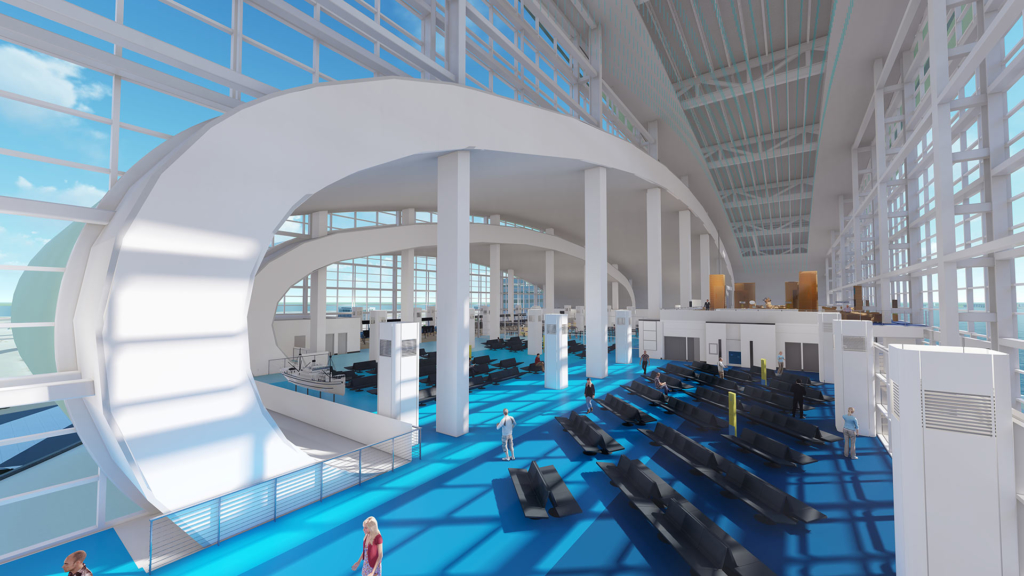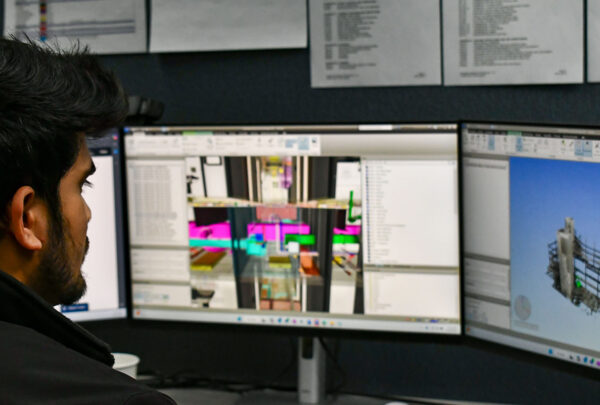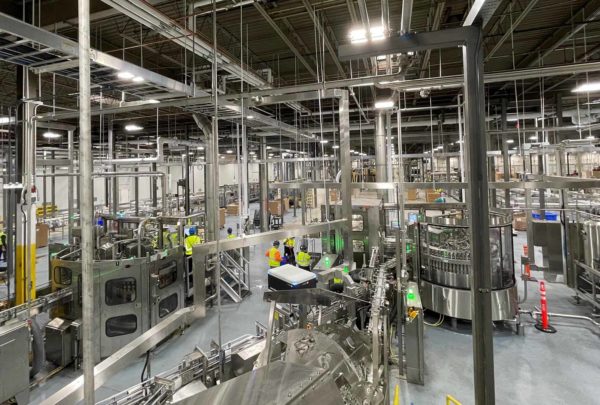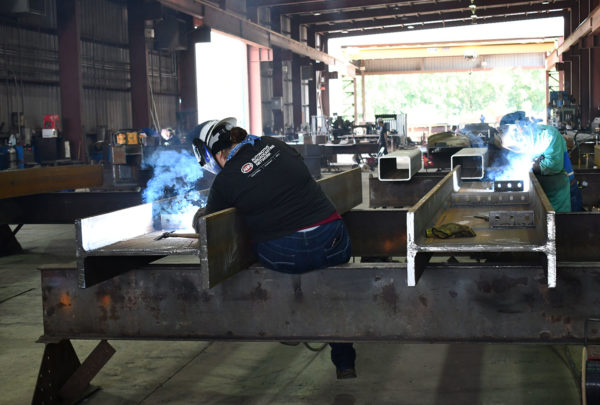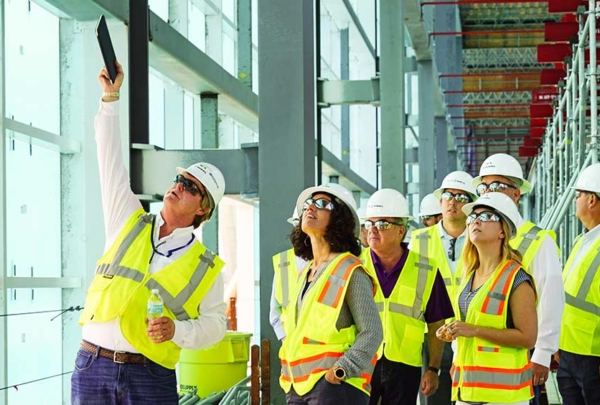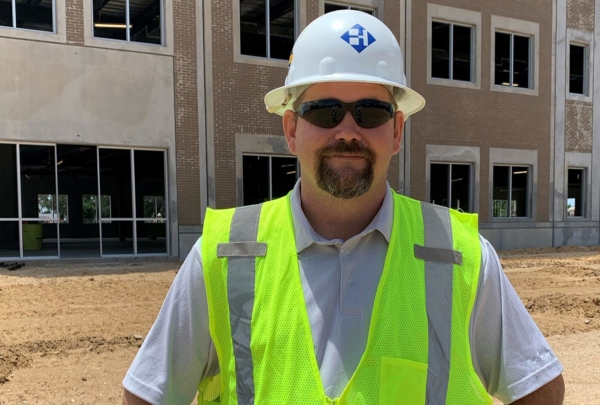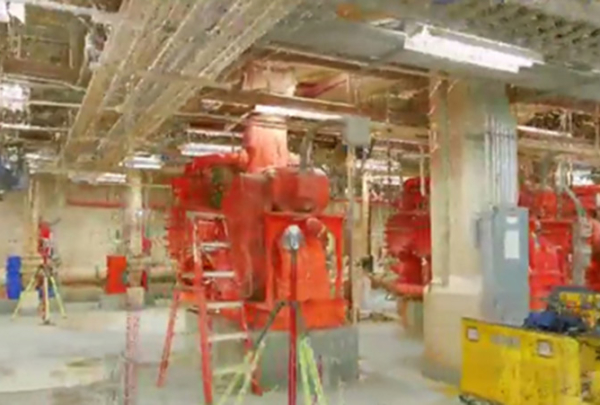As a pioneer in design-build delivery, Haskell always has worked across the architectural, engineering and construction disciplines throughout the lifecycle of a project, collaborating with project owners every step of the way.
But now Haskell’s teams don’t just communicate with the owner. They show them the future, adding time and cost components to the design-build experience to produce 4D and 5D animated construction simulations.
“The reaction we get from the owner is the highlight of the meeting,” said Justin Barrette, manager of Virtual Construction at Haskell. “They are excited about the project and want to see it again and again.”
Employing the latest digital technology, Haskell’s holistic approach to project delivery comes to life using Building Information Modeling (BIM). Architects and engineers design in software systems that combine the computer-generated 3D modeling and database-driven tools of the architectural, engineering and construction (AEC) industry with those developed in the video game industry to create and fully realize the 3D conceptual designs.
Clients see exactly what they are purchasing. They also see improved efficiency and considerable cost savings, with Haskell’s ability to downstream design model data into construction, with direct ties into estimating, scheduling, coordination, prefabrication, field layout and execution.
Leveraging BIM to its fullest potential through Virtual Design and Construction (VDC) workflows, designers, construction managers and subcontract partners can detect and resolve myriad problems during design and prefabrication, pre-empting costly delays and change orders in the field. Then, further utilizing this technology in the field execution phase, Haskell maximizes productivity and jobsite safety.
“It prevents rework from happening in the field,” Barrette said. “We look for every opportunity to prefabricate in a controlled environment.”
VDC: Virtual Design & Construction
We are all familiar with popular home remodeling television shows. Critical plotlines play out when “hidden” problems reveal themselves. VDC prevents such surprises. Through automated clash detection and virtual facility walkthroughs, significant problems are discovered well before any real work begins.
“Customers are confident in the information they are getting from us,” Barrette said.
Haskell also uses BIM and VDC when repurposing existing structures. In the past, renovation projects relied on outdated record, or “as-built,” drawings. If available at all, these original drawings often fail to reflect work done since the building was constructed.
VDC employs rapid collection of field measurements using 3D laser scanning and drones for aerial mapping. This allows Haskell to scan the job site and capture measurements, 360-degree photos and topographic contour data of the existing facility and overall site. It proves more accurate than taking multiple trips with a team of architects and engineers, capturing limited photos, sketches, and a few key measurements.
With accurate measurements, architects and engineers can create a 3D representation of the facility to enable the new design process, with or without client-provided record drawings. Customers are amazed at the detail that is achieved. Using this framework of existing conditions, designers and engineers can then explore multiple scenarios to reroute ductwork, electrical and plumbing to accommodate building changes. This allows for the best possible use of space and enhances building functionality.
Growth of BIM in the Construction Industry
Once land is cleared, the site can be staked using Robotic Total Station (RTS) layout equipment, which enables a single worker to perform layout while the robot tracks the position of the layout operator carrying the prism pole. This enables highly accurate location staking for self-perform concrete layout and quality assurance of other trades onsite, and it is done in a matter of days with greater accuracy than using traditional surveying methods. RTS pinpoints the location of such things as the placement of concrete foundations, anchor bolts for future steel column placement, underground utilities and piping penetrations.
Robotic layout technologies modernize the construction process, bridging the gap between design drawings and field execution, Barrette said.
Integrating laser scanning again during construction progress provides real-time feedback so the team to make informed decision regarding construction tolerances. Crews can immediately detect a problem – for example, if steel were installed out of tolerance prior to prefabricated glass installation – and correct it before it multiplies into a costly and time-consuming fix.
“Here at Haskell, we are always looking for creative ways to execute our work more efficiently. How can we accomplish our work more accurately in less time with less resources to maximize our efficiency?” Barrette said.
Pushing BIM To Its Limits
As part of a joint venture with Miami-based NV2A, Haskell crews employed never-before-seen uses of virtual construction technology to drive unprecedented speed and an unmatched level of quality in creating the award-winning Norwegian Cruise Line Cruise Terminal B at PortMiami.
“The NV2A/Haskell Joint Venture delivered a highly complex project under challenging conditions with complete excellence,” said Pete Kinsley, President of Haskell’s Infrastructure & Transportation Delivery Group. “Innovative use of Building Information Modeling, or BIM technology, enabled us to execute with precision, speed and quality. We satisfied all primary objectives for Norwegian Cruise Line, as well as those for PortMiami.”
While many large-scale projects follow a process of planning, architectural design, engineering, detailed plans, shop drawings, field-dimensioning, fabrication, construction, etc., the JV team took a different approach, applying building information modeling (BIM) and virtual construction at an unprecedented level.
- BIM was used for all design and trade coordination. Frequent measurement with robots, laser scanning and regular data assimilation into the model kept competing tolerances in balance and informed construction work in real-time.
- The steel system, which comprised more than 8,000 tons of structural steel, needed to be fabricated in more than a half-dozen different shops to meet production schedules. The team reviewed the structural model daily with engineers and detailers, followed by physical inspections in the shops to confirm details, welding procedures and dimensional accuracy. This assured the precise erection of a steel structure comprising massive, atypical, radiused structural members
- The team selected a vendor in Colombia that prefabricated the more than 100,000 square feet of curtain wall in modules directly from the BIM model rather than from measurements in the field. The modules were delivered in 12-foot-by-16-foot sections that were easily erected with glazing already installed in the frames. The real-time, hyper-accurate model saved six months of construction time.
“We definitely pushed our BIM, Reality Capture and Digital Layout capabilities to leverage our construction model – not only for coordination of the challenging building design but also for our logistics planning inside the terminal and around the site,” said Danny Parmenter, who was Haskell’s Construction Executive on the project. “We accomplished a lot of great things that would have been extremely difficult, if not impossible, to do accurately without our technologies.”
BIM-enabled technology and VDC workflows reduce risk and keep jobs moving. Delivering work when promised builds customer confidence and further grows Haskell’s reputation as a proven industry performer.
Haskell uses virtual design and construction through all phases of the project lifecycle to maximize project efficiency. Contact our VDC team to discuss – and even virtually envision – your facility needs.

